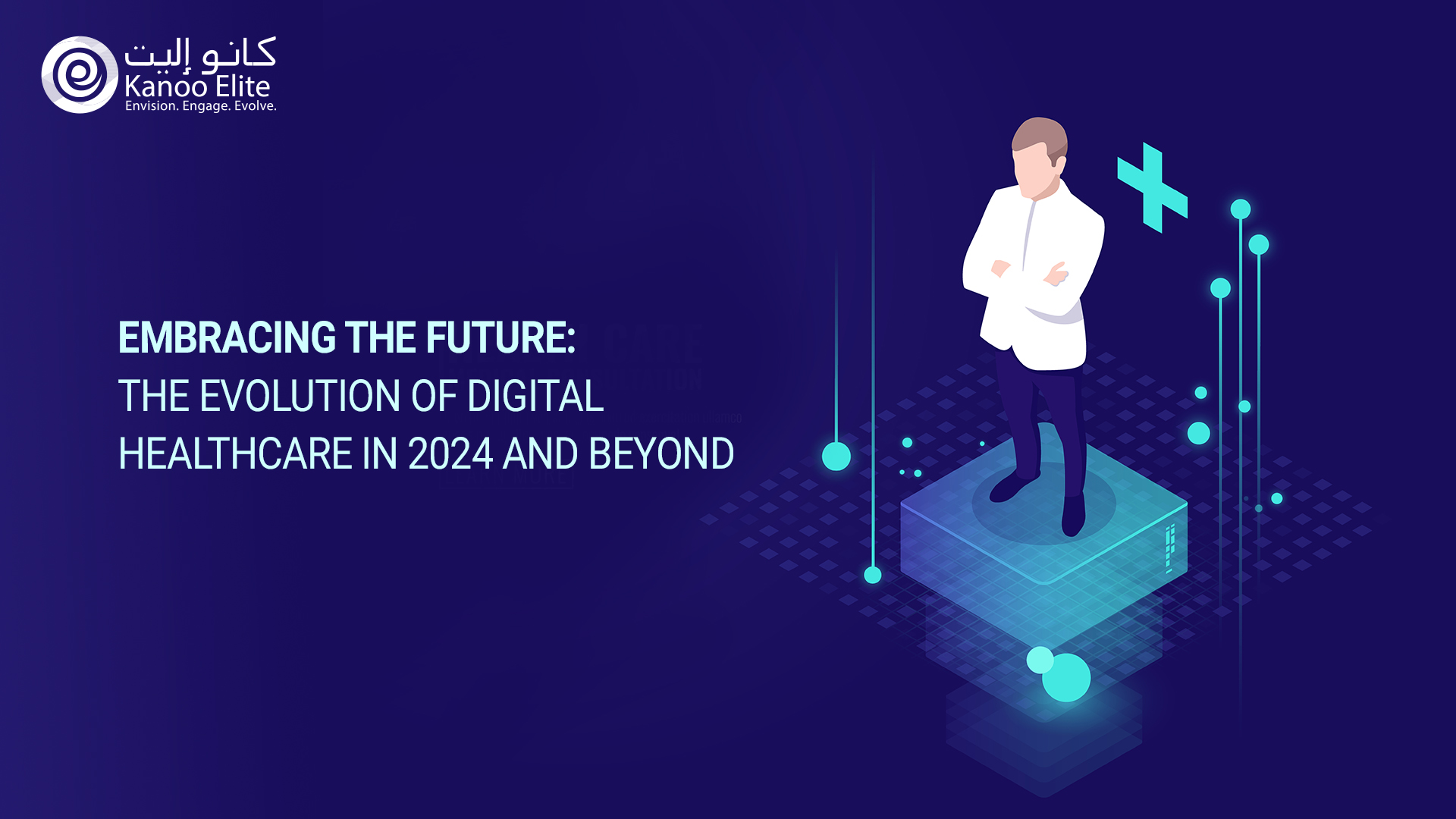The landscape of healthcare has been undergoing a profound transformation in recent years, with the rapid integration of digital technologies reshaping how we approach wellness and medical care. As we step into 2024, the evolution of digital healthcare is poised to reach new heights, promising improved patient outcomes, increased accessibility, and a more interconnected healthcare ecosystem.
I. The Foundation: Electronic Health Records (EHRs)
One of the cornerstones of the digital healthcare revolution is the widespread adoption of Electronic Health Records (EHRs). In 2024, we find these digital repositories of patient information becoming more comprehensive, interoperable, and secure. Healthcare providers can seamlessly share patient data, leading to more coordinated and efficient care.
The integration of Artificial Intelligence (AI) and machine learning algorithms with EHRs has further enhanced their capabilities. These advanced technologies help in analyzing vast amounts of data to identify patterns, predict disease progression, and provide personalized treatment plans. Patients, too, have greater access to their own health records, empowering them to take a more active role in managing their well-being.
II. Telemedicine and Remote Patient Monitoring
The COVID-19 pandemic accelerated the adoption of telemedicine, and in 2024, it has become an integral part of the healthcare landscape. Virtual consultations and remote monitoring technologies have not only provided a solution to pandemic-related challenges but have also proven to be convenient for patients and cost-effective for healthcare systems.
Telemedicine platforms have evolved to offer a broader range of services, including mental health support, chronic disease management, and preventive care. Wearable devices and sensors are now capable of continuously monitoring vital signs and transmitting real-time data to healthcare providers. This enables early detection of health issues and allows for timely intervention, reducing hospitalizations and improving patient outcomes.
III. AI in Diagnostics and Treatment Planning
The integration of Artificial Intelligence (AI) into diagnostics and treatment planning is a transformative force propelling digital healthcare into new realms in 2024 and beyond. AI’s capacity to analyze vast datasets and discern patterns at speeds beyond human capability has revolutionized the accuracy and efficiency of medical decision-making.
In diagnostics, AI algorithms have evolved to interpret medical imaging, pathology slides, and genetic data with unprecedented precision. Radiology benefits immensely from AI, where machine learning models assist in detecting anomalies in X-rays, MRIs, and CT scans. Not only does this expedite the diagnostic process, but it also enhances the early detection of diseases, significantly impacting patient outcomes.
Moreover, AI is increasingly playing a pivotal role in pathology, assisting pathologists in identifying and classifying abnormalities in tissue samples. The speed and accuracy with which AI algorithms can analyze pathology slides contribute to faster and more accurate diagnoses, thereby facilitating timely and targeted treatment plans.
Treatment planning, too, has witnessed a paradigm shift with the incorporation of AI. Machine learning algorithms analyze diverse datasets, including patient history, genetic information, and treatment outcomes, to formulate personalized and optimized treatment strategies. This level of precision ensures that patients receive interventions tailored to their specific characteristics, improving the efficacy of therapies and minimizing potential side effects.
Furthermore, AI facilitates predictive analytics, helping healthcare providers anticipate disease progression and response to treatment. By continuously learning from new data inputs and adjusting recommendations accordingly, AI-driven treatment plans evolve over time, reflecting the dynamic nature of a patient’s health.
In the future, the synergy between AI and healthcare is expected to deepen, with the potential to unlock new frontiers in precision medicine. As AI algorithms become more sophisticated and integrated into the fabric of digital healthcare, the promise of personalized, efficient, and effective diagnostics and treatment planning is set to reshape the healthcare landscape, offering unprecedented advancements in patient care and outcomes.
IV. Blockchain Technology for Enhanced Security
In 2024, the integration of blockchain technology stands as a cornerstone in fortifying the security of digital healthcare. As the healthcare industry continues its digital transformation, concerns about data privacy, security breaches, and unauthorized access have become increasingly prominent. Blockchain, with its decentralized and tamper-resistant nature, emerges as a robust solution to address these challenges.
At its core, blockchain is a distributed ledger that records transactions across a network of computers, ensuring that data remains secure and unalterable. In the context of healthcare, this technology enhances the security of patient data by providing a transparent and immutable record of transactions. Each block of data is linked to the previous one in a chronological chain, creating a secure and traceable history of information.
One of the primary advantages of blockchain in healthcare is its ability to establish a decentralized system for managing patient records. Traditionally, patient data is stored in centralized databases, making them susceptible to hacking and unauthorized access. With blockchain, patient information is distributed across a network of nodes, reducing the risk of a single point of failure and enhancing the overall security posture.
Moreover, blockchain facilitates granular control over data access. Patients can determine who has permission to access their health records, providing them with a sense of ownership and control over their sensitive information. This not only aligns with the principles of patient-centric care but also fosters trust between healthcare providers and their patients.
As the healthcare ecosystem becomes more interconnected, the need for secure and interoperable systems becomes paramount. Blockchain’s decentralized nature ensures that information can be shared seamlessly across different healthcare entities while maintaining the integrity and confidentiality of the data. In 2024 and beyond, the integration of blockchain technology represents a pivotal step towards creating a more secure, transparent, and patient-centric digital healthcare environment.
V. The Rise of Digital Therapeutics
The healthcare landscape is witnessing a remarkable transformation with the ascendancy of digital therapeutics in 2024. This innovative branch of digital healthcare represents a paradigm shift, redefining how we approach the prevention and treatment of various medical conditions. The rise of digital therapeutics is not only a testament to technological advancements but also a herald of a more patient-centric and accessible era in healthcare.
Digital therapeutics are software-based interventions that leverage digital technologies to deliver evidence-based therapeutic solutions. In 2024, we are witnessing a surge in the development and adoption of these solutions across diverse medical domains. From mental health and chronic disease management to rehabilitation and preventive care, digital therapeutics are proving to be versatile tools that complement traditional healthcare approaches.
One of the key drivers behind the rise of digital therapeutics is their ability to provide personalized and targeted interventions. These solutions analyze real-time data, incorporating user inputs and health metrics to tailor treatment plans for individual patients. This personalized approach not only enhances the efficacy of interventions but also empowers individuals to actively participate in their healthcare journey.
Accessibility is another hallmark of the digital therapeutics revolution. With the increasing prevalence of smartphones and connected devices, patients can access these therapeutic interventions from the comfort of their homes. This not only improves convenience but also reduces barriers to healthcare access, especially for individuals in remote or underserved areas.
Furthermore, the integration of digital therapeutics into the broader healthcare ecosystem is fostering a more comprehensive and coordinated approach to patient care. These interventions seamlessly interface with electronic health records (EHRs) and share relevant data with healthcare providers, facilitating a continuous feedback loop that informs and refines treatment strategies.
Looking beyond 2024, the rise of digital therapeutics holds the promise of not just treating diseases but preventing them altogether. As technology continues to advance, we can anticipate a future where digital therapeutics play a central role in personalized and preventive medicine, ushering in a new era of healthcare that is proactive, patient-focused, and digitally empowered.
VI. Interoperability and Data Exchange
The future of digital healthcare hinges on the seamless exchange of information between different healthcare entities. Interoperability, the ability of different systems and applications to communicate and share data, is a key focus in 2024. Efforts are being made to establish standardized data formats and communication protocols to ensure compatibility between diverse healthcare platforms.
The benefits of interoperability are immense and many of them play extremely important roles. Interoperability facilitates smoother transitions of care. Moreover, it reduces duplicative tests and procedures, and ultimately leads to better-informed decision-making. However, it’s true that achieving perfect interoperability remains a complex challenge. Nevertheless, ongoing collaborations and technological advancements are paving the way for a more interconnected healthcare ecosystem.
Conclusion
The evolution of digital healthcare in 2024 has brought about transformative changes that are reshaping the entire healthcare landscape. From advanced EHRs and telemedicine to AI-driven diagnostics and digital therapeutics, these innovations are driving a paradigm shift in how we approach wellness and medical care.
As we look beyond 2024, the trajectory of digital healthcare points toward even greater integration of emerging technologies, improved collaboration between stakeholders, and a more patient-centric model of care. Embracing this future entails not only embracing technological advancements but also addressing challenges related to data security, interoperability, and ethical considerations.
In the years to come, the synergy between technology and healthcare will continue to unfold, bringing us closer to a future where healthcare is not only more efficient and accessible but also more personalized and human-centered. The journey towards the next frontier of digital healthcare promises to be an exciting one, with the potential to revolutionize the way we understand and experience health and well-being.



